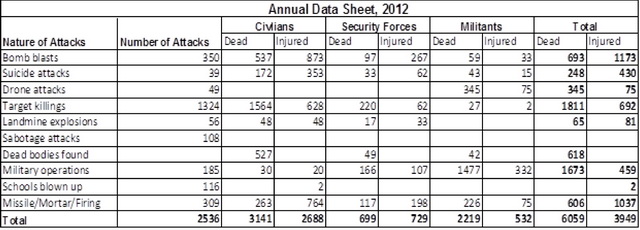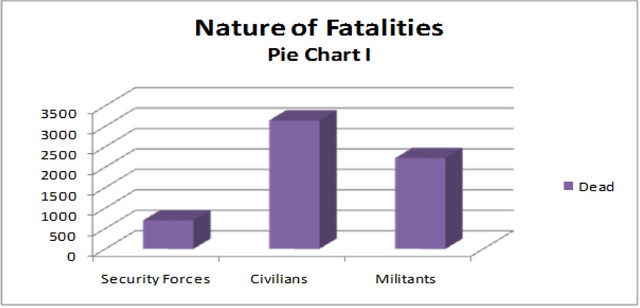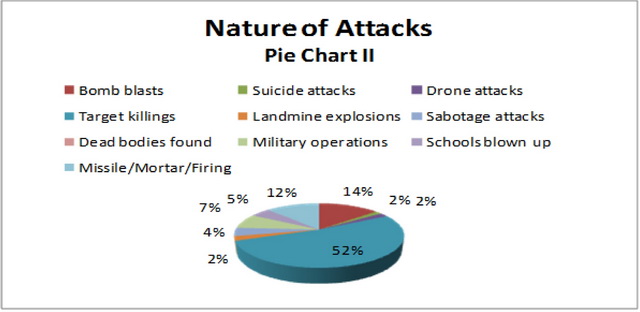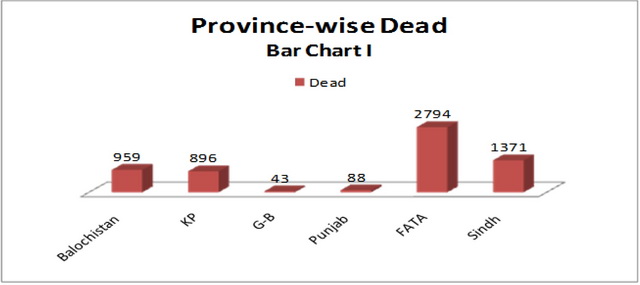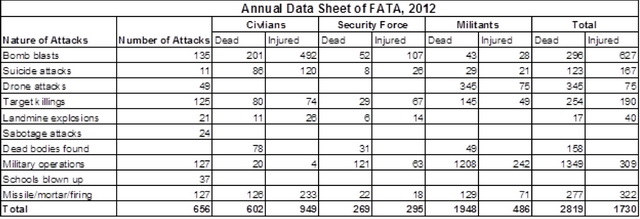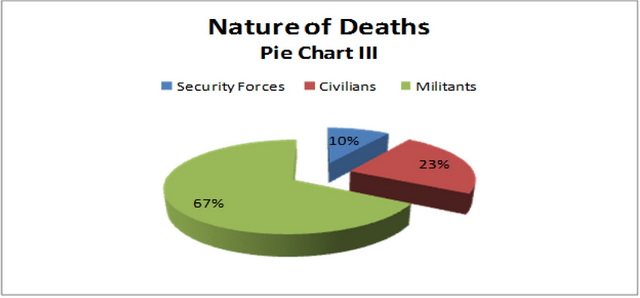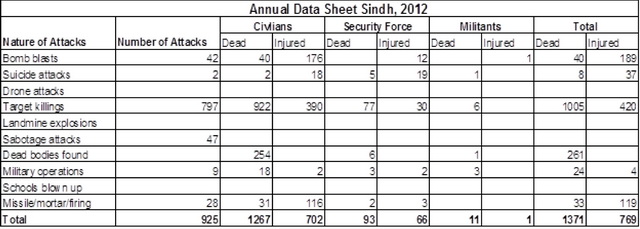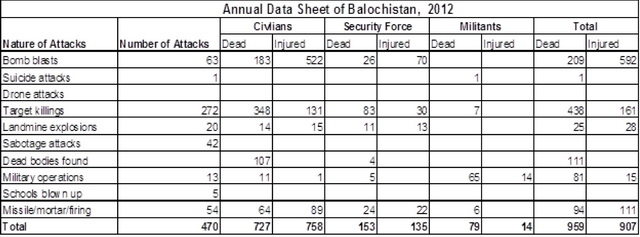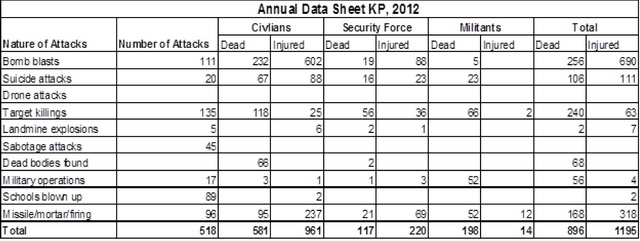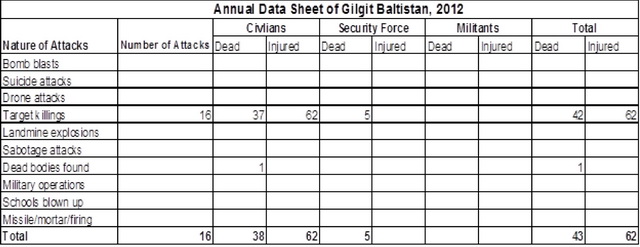The overall level of violence declined by almost 15 percent during 2012[1] across Pakistan.[2] Meanwhile, ethno-political violence in Karachi (Sindh), religio-political terrorism in Federally Administered Tribal Areas (FATA) and Khyber Pakhtunkhwa (KP), and nationalist-separatist violence in Balochistan continued unabated. The deadly wave of target killings in Karachi, presumably triggered by the rivalry between Muttahida Qaumi Movement (MQM) and Awami National Party (ANP) in March, has continued to date, claiming almost 991 persons, as a result of 791 violent attacks in the course of 2012. Among these 917 were civilians and 74 security forces– men. The data collected throughten newspapers that CRSS uses as the source, underlines that as a whole, 6059 persons perished during 2012, as a result of 2536 incidents of violence (for details see data sheet below).
A concise look into the casualty figures underlines that the civilians remained the major target of violent acts, with the civilians accounting for almost 52 percent of the total deaths off various forms of violence and terror across Pakistan. As noted in pie chart I below, 3041 civilians were dead in 2012. Moreover, the data suggests that the militants fighting against the state remained the second major target of violence i.e. 37 percent of the total dead. Clashes between militants and security forces also left 699 security forces– personnel (11 percent of total deaths) dead and these were mostly recorded in insurgency infested areas of FATA, Karachi and Balochistan. Furthermore, during 2012, 49 CIA operated drone strikes were reported in different areas of Pak-Afghan bordering areas, mostly in North and South Waziristan agencies (FATA), leaving as many as 345 suspected militants dead. Meanwhile, continuing their sabotage campaign to demolish state infrastructure, militants blew up 116 private and state-run schools in different parts of FATA and KP during the course of current year. Also 108 sabotage attacks were reported, mostly in Balochistan, targeting power pylons and gas pipelines.
In 2012, target killing remained the major cause of deaths. Pie chart II below shows that 52 percent of all the violent incidents were of target killing in nature, accounting for 31 percent of the total death toll. Numerically 1811 persons were shot dead across Pakistan, as a result of 1324 incidents of target killing. Among these a whopping 1564 deaths were of civilians, while 220 security forces– men and 27 militants also fell prey to target killings. Meanwhile, deadly clashes between military and militants were the second major cause of deaths. As a result of which, as many as 1673 persons perished, including 1477 militants and 166 security forces personnel, mostly in different parts of KP and FATA. During current year, 618 dead bodies were also recovered from different parts of Pakistan, most of them, were found in Karachi, Peshawar, FATA and Balochistan. The third major cause of the violence was bomb blasts. In total, 693 persons including 537 civilians, 97 security forces– personnel and 59 militants perished in this form of violence across the state. Likewise, 39 suicide attacks left 248 persons dead and another 430 injured in different parts of the country, but again most of these attacks were witnessed in KP and FATA.
A peer into the territory and intensity of violence at national level underlines that FATA witnessed major loss of lives during the current year, wherein almost 2794 persons were butchered (as shown in bar chart I below). After FATA, surprisingly enough, Sindh due to large scale killings in Karachi turned out to be the second major hub of violence, where ethno-political, sectarian and criminal violence left almost 1371 people dead during the current year. Meanwhile, violence across KP and Balochistan decimated almost equal number of persons during the course of the year.
Moreover, the sporadic waves of sectarian violence continued to pile up misery in Pakistan, especially for Shia Muslims. In 2012, 368 people were killed out of sectarian motives; majority belonging to Shia minority sect (295), in Parachinar (FATA), Quetta (Balochistan) and Karachi (Sindh). Majority of the victims of sectarian violence were Hazara community people residing in and around Quetta. Latest trends in sectarian violence across Pakistan underscore the fact that this sort of violence is on the rise once again.
Provincial Overview
FATA
As in case of preceding year, once again, FATA emerged as the epicenter of violence during 2012. As data sheet below underlines that overall 2819 people were dead in the region, as a result of 656 violent attacks. These attacks included: 11 suicide attacks, 135 bomb blasts and 49 drone attacks in the area. Military operations involving military and militants eaten up a staggering 1349 persons and 1208 among these were militants.
As depicted in pie chart III below, some 67 percent of the total deaths in FATA were of militants, while security forces accounted for 23 percent of the total loss of lives. Although, militants and security forces are main actors involved in the bloody war, yet civilians also figure out in cross fires and blasts. During 2012, 602 (10 percent of the total) dead were civilians.
Sindh
After FATA, Sindh emerged as the second major hub of violence during 2012. As data sheet below underlines that overall 1371 people were dead in the area, as a result of 925 violent attacks. These attacks included: two suicide attacks, 42 bomb blasts and a staggering 797 incidents of target killing in the province and almost 98 percent of these attacks occurred in Karachi alone. Also, 261 dead bodies were recovered from different areas of the city. Most of the victims of violence in the city were civilians i.e. 1267 of the total death toll.
Balochistan
After Sindh, Balochistan fell next on the ladder of violence during 2012. As data sheet below shows that overall 959 people were dead in the province, as a result of 470 violent attacks. These attacks included: one suicide attacks, 63 bomb blasts and 272 incidents of target killing in the province. Target killing continued to be the major weapon in the hands of miscreants to inflict violence. Also, 111 dead bodies were recovered from different areas of the province. Most of the victims of violence were civilians i.e. 727 of the total death toll.
KP
After Balochistan, KP was the fourth major hub of violence during 2012. As data sheet below shows that overall 896 people were dead in the province, as a result of 518 violent attacks. These attacks included: 19 suicide attacks, 111 bomb blasts and 135 incidents of target killing in the province. Target killing continued to be the major weapon in the hands of militants to inflict violence and 240 persons were shot dead in 2012. Also, 68 dead bodies were recovered from different areas of the province. Most of the victims of violence were civilians i.e. 581 of the total death toll.
Punjab
Punjab was the fifth major center of violence during 2012, but the overall level of violence as compared to other provinces was substantially low. As data sheet below shows that overall 88 people were dead in the province, as a result of 17 violent attacks. These attacks included: two suicide attacks, four bomb blasts and seven incidents of target killing in the province. Also, one dead body was recovered from the province. Most of the victims of violence were civilians i.e. 46 of the total death toll.
Gilgit-Baltistan
Gilgit-Baltistan witnessed lowest level of violence during 2012, as compared to other provinces. As data sheet below shows that overall 88 people were dead in the province, as a result of 17 violent attacks. These attacks included: two suicide attacks, four bomb blasts and seven incidents of target killing in the province. Also, one dead body was recovered from the province. Most of the victims of violence were civilians i.e. 38 of the total death toll.
The trends and territory of violence across the country underscore that law and order situation across Pakistan remains volatile, while law enforcement agencies look incapable and ill-equipped to address this persistent volatility of the security situation. Meanwhile, at a time when state security continues to deteriorate; the political leadership looks apathetic as ever to find the solution and erect policy measures to stall this plunge.
Sources:
- The News
- Dawn
- The Express Tribune
- Pakistan Today
- Daily Times
- The Frontier Post
- Jang (Urdu)
- Daily Mashriq (Urdu)
- Aaj (Urdu)
- The Nation
[1] Data compiled by CRSS from January 1, 2012 to December 31, 2012.
[2] Estimates in Pakistan Security Report 2011, published by the Pakistan Institute of Peace Studies (PIPS), over all 7107 people were killed across Pakistan in 2985 incidents of violence during 2011.

